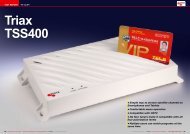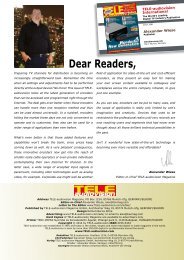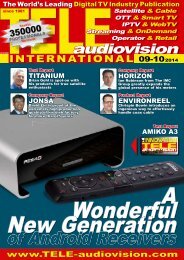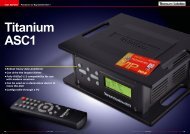eng TELE-audiovision 1411
The World’s Largest Digital TV Trade Magazine
The World’s Largest Digital TV Trade Magazine
Create successful ePaper yourself
Turn your PDF publications into a flip-book with our unique Google optimized e-Paper software.
TEST REPORT<br />
One Cable LNB<br />
What Is a One Cable LNB?<br />
The universal LNB for Ku-<br />
Band has become something<br />
so standard that many of us<br />
think that nothing else is offered<br />
on the market. That<br />
is not true. There are other<br />
products available. And<br />
one of such non-standard<br />
LNB for Ku-Band is the MX-<br />
OCS12 of Maxing. The manufacturer<br />
calls it “one cable<br />
LNB” and this needs some<br />
explanation.<br />
The MX-OCS12 converts<br />
two specific sub bands of the<br />
lower part of the Ku-Band<br />
to the L-Band. These sub<br />
bands are: 10.7~11.2 GHz<br />
at vertical polarization and<br />
11.45~11.7 GHz at horizontal<br />
polarization. Because its<br />
local oscillator works at the<br />
typical frequency of 9.75<br />
GHz, the two sub bands are<br />
shifted into the following<br />
frequency ranges in L-Band:<br />
OCS12 LNB looks as a typical<br />
product for Ku-Band. Quality<br />
of workmanship is excellent<br />
but as we have noted before,<br />
Maxing uses lables printed<br />
on paper. Whilst this would<br />
not concern us much with<br />
any regular LNB in this case<br />
with such a special LNB it<br />
might be good to be able to<br />
read the specifications also<br />
after the LNB is exposed<br />
to the outdoor world being<br />
mounted on a dish.<br />
Of course, the type of lable<br />
on a LNB is not at all critical.<br />
What really counts is the<br />
product performance. For<br />
our <strong>TELE</strong>-<strong>audiovision</strong> test<br />
we selected the HOTBIRD on<br />
13° East as our source of signal<br />
and a modern universal<br />
LNB as our reference LNB.<br />
Our measurements revealed<br />
0.95~1.45 GHz and 1.7~1.95<br />
GHz. Now, the trick is that<br />
you can connect more than<br />
one satellite receiver to the<br />
output: if only one of the<br />
receivers supplies the MX-<br />
OCS12 LNB with d.c. voltage<br />
(in the range of 11.5~19<br />
volts) all the other receivers<br />
in the chain may have<br />
their LNB power switched<br />
off. Now the question is:how<br />
many receivers can then<br />
be connected to that one<br />
LNB? Well, this depends on<br />
the sockets you will use.<br />
The sockets have splitters<br />
that may differ in insertion<br />
and tap losses. With typical<br />
sockets, you should be able<br />
to connect 8~10 receivers to<br />
the output of the MX-OCS12<br />
LNB and all of them wil be<br />
able to tune into the above<br />
mentioned two sub bands.<br />
From the outset the MXthat<br />
the MX-OCS12 LNB performed<br />
very well in its vertical<br />
sub band (10.7~11.2<br />
GHz). It generated stronger<br />
signals than the reference<br />
LNB without compromising<br />
signal quality. MER was<br />
practically identical with the<br />
reference LNB. Moreover,<br />
it was able to work even at<br />
11.279 GHz so the vertical<br />
sub band was slightly wider<br />
than promised.<br />
Output signal for the horizontal<br />
sub band was a little<br />
bit weaker than our reference.<br />
Also signal quality was<br />
somewhat poorer. MER was<br />
by 0.5~1.5 dB lower than<br />
our reference. However,<br />
MER=12 dB still guarantees<br />
very solid reception even in<br />
terrible weather conditions.<br />
So, if the MX-OCS12 LNB is<br />
used for a similarly strong<br />
satellite as HOTBIRD then its<br />
slightly weaker performance<br />
in horizontal sub band will be<br />
unnoticeable.<br />
The MX-OCS12 LNB by<br />
Maxing is a unique solution<br />
to some special situations,<br />
mainly when only the transponders<br />
on the two sub<br />
bands, which the MX-OCS12<br />
LNB supports, need to be<br />
received. In such a case<br />
the MX-OCS12 LNB allows<br />
for a very simple chain installation,<br />
as normally used<br />
in regular terrestrial tv dis-<br />
11-12/2014<br />
MAXING MX-OCS12<br />
Perfect for using with existing tv cabling<br />
www.<strong>TELE</strong>-<strong>audiovision</strong>.com/14/11/maxing<br />
52 <strong>TELE</strong>-<strong>audiovision</strong> International — The World‘s Leading Digital TV Industry Publication — 11-12/2014 — www.<strong>TELE</strong>-<strong>audiovision</strong>.com

















